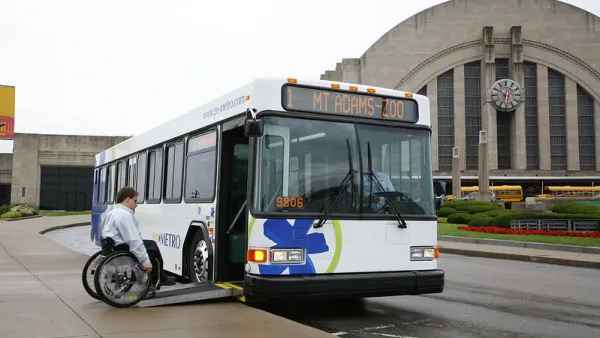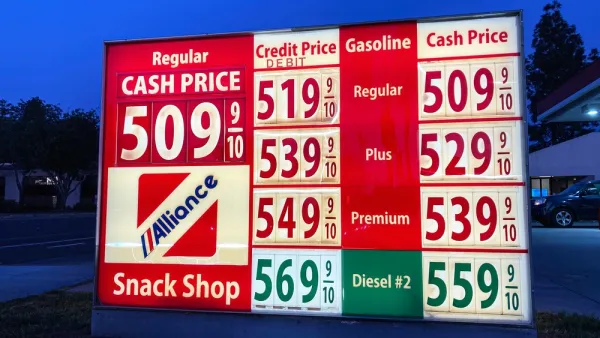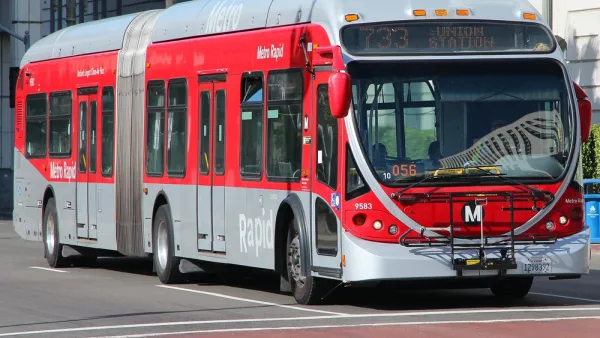As gas prices inch beyond $4 a gallon, transit trips increase by 3.3% for the first quarter of the year and vehicle miles traveled drop 4.3% in March.
"Americans took 2.6 billion trips on all modes of public transportation, including subways and buses, in the first three months of 2008, a 3.3 percent increase, or almost 85 million more trips than in the same period last year, according to a report released Monday by the American Public Transportation Association (APTA).
"There's no doubt that the high gas prices are motivating people to change their travel behavior," says William Millar, APTA president.
The ridership increase is noteworthy because it occurred when the economy was declining, said APTA, a transportation industry group. Sixty percent of transit trips are work-related, so for ridership to jump when the economy is flat or on the decline signals an increase in demand that is likely to continue if gas prices remain high, said Rob Padgette, APTA's director of policy, development and research. "It is a significant number," he said.
Even more noteworthy, Padgette said, is that ridership at many transit agencies increased despite higher fares...
That's a stunning thing and says to us that demand is there even if we raise fares," Padgette said, referring to the national statistics. "We haven't had this situation before where the ground is shifting underneath us. Fuel prices are at a totally different level than ever before, and we are facing surging demand."
"The U.S. Transportation Department reported last month that in March, Americans drove 11 billion fewer miles than in March 2007, a decline of 4.3 percent and the first time since 1979 that traffic has dropped from one March to the next."
"Of all modes, bus transit showed the lowest ridership increase - 2 percent nationwide."
While ridership jumps, some transit agencies and state budgets have reduced transit funding. In California, Gov. Schwarzenegger has shifted $1.4 billion from the Public Transportation Account to the general fund to help balance a state budget deficit that exceeds $17 billion. [See related link].
Thanks to ABAG-MTC Library
FULL STORY: More Travelers Are Turning to Public Transit

National Parks Layoffs Will Cause Communities to Lose Billions
Thousands of essential park workers were laid off this week, just before the busy spring break season.

Retro-silient?: America’s First “Eco-burb,” The Woodlands Turns 50
A master-planned community north of Houston offers lessons on green infrastructure and resilient design, but falls short of its founder’s lofty affordability and walkability goals.

Delivering for America Plan Will Downgrade Mail Service in at Least 49.5 Percent of Zip Codes
Republican and Democrat lawmakers criticize the plan for its disproportionate negative impact on rural communities.

Test News Post 1
This is a summary

Test News Headline 46
Test for the image on the front page.

Balancing Bombs and Butterflies: How the National Guard Protects a Rare Species
The National Guard at Fort Indiantown Gap uses GIS technology and land management strategies to balance military training with conservation efforts, ensuring the survival of the rare eastern regal fritillary butterfly.
Urban Design for Planners 1: Software Tools
This six-course series explores essential urban design concepts using open source software and equips planners with the tools they need to participate fully in the urban design process.
Planning for Universal Design
Learn the tools for implementing Universal Design in planning regulations.
EMC Planning Group, Inc.
Planetizen
Planetizen
Mpact (formerly Rail~Volution)
Great Falls Development Authority, Inc.
HUDs Office of Policy Development and Research
NYU Wagner Graduate School of Public Service





























